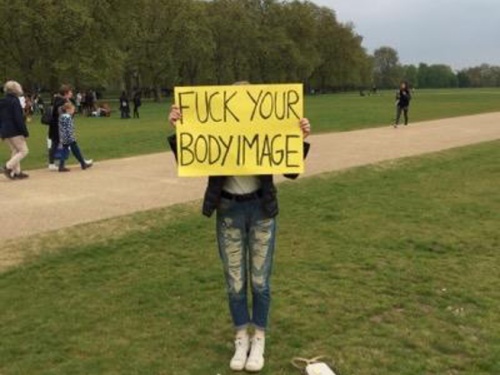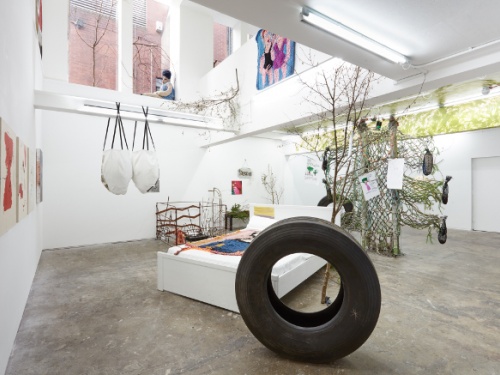The Subtle Abyss: Visual Representation and Feminist Art Practices
How can feminist art intervene in dominant patriarchal culture? Ahead of our exhibition and programme of video works, performances and panel discussions Feminist Practices in Dialogue, and coinciding with the release of a new publication of the same name, Rose Gibbs and Catherine Long explore this question and reflect on the troubling impact of neoliberalism.
The economic orthodoxy of neoliberalism, promoting rational self-interest through deregulation, privatisation, free trade and ever-smaller government, sees its cultural equivalent in an ‘anything goes’ attitude that divorces actions and behaviours from the circumstances in which they are generated.
This orthodoxy presupposes that we are all born free, that we make choices freely and that we are not shaped by normative expectations. Here, the subject is a lone individual to whom all bonds—filial or otherwise—are burdensome. There is an underlying assumption that there is a just and ‘natural’ way of being and that this will somehow emerge. Similarly, the free-market is assumed to be a self-regulating ‘ecosystem’, which—like the natural world—might at times be brutal, but is ultimately harmonious.
In today’s neoliberal culture it is unclear if the barriers to freedom imposed by class, race and gender discrimination are recognised. There is a libertarian celebration of free will that does not question or think through the conditions that might make real freedom possible.
In a reversal of the feminist tenet "the personal is political", problems are never political but always personal: individual, sui generis and hence unanalysable. In these circumstances, bringing people together to address common issues becomes increasingly difficult. Furthermore, assuming that we are all autonomous individuals effectively obscures the truth of our predicament. This is particularly worrying for vulnerable and marginalised people.
Currently, we are in the midst of a resurgence of feminism in the west and globally, which continues to gather momentum. The last five years has seen a significant increase in feminist conferences, grassroots activism and feminist art-making and exhibitions. Much of this organising takes place in the face of the continued discrimination and the realisation among younger women that we have been sold a fabrication: equality has been achieved making feminism redundant. At the same time, capitalism has co-opted the language of feminism in the mainstream media. Backlash against feminism has taken on its most virulent form: behaviours and products that are all part of the capitalist arsenal are recast as feminist tools of ‘empowerment’, while the derivation of that power remains strikingly unexamined.
Women, now earners, have become the objects of aggressive marketing tactics; we are told that the (feminine) subject manifests her freedom through her power to purchase.
Noticeable too, is that these behaviours tend to fit with the ethos of a society that continues to punish those who do not conform to its standards and obligingly serve its demands. The current state of mainstream cultural achievement for women often appears to be the right to objectify ourselves and be grateful for the privilege of visibility, a visibility that is still only awarded to those women who fit the limited slender, light-skinned, youthful ideal prevalent in heteronormative capitalist culture. This mainstream popular feminism invites us all to disavow our roots and pick up the symbols of the west: wear western dress, discard international or regional accents, alter our hair, and take up western kinship relationships. Here, the nuclear rather than the extended family takes pride of place. This insidious encroachment of neoliberalism reduces feminism to a set of ‘personal’ rights and choices that neatly dovetail with capitalism, while effectively undermining the whole project. If feminism doesn’t stand for anything, how do we know what it is, or the ways in which it could liberate us?
In this context, continuing feminist discussions is all the more urgent, if feminism is to remain a meaningful ideology.
At Suzanne Lacy’s 2013 Silver Action performance at The Tate Modern, one of the older feminist activists commented that second wave feminism won the battle for legislation but left younger generations with the battle for culture. The struggle around visual representation is one that feminist artists have always been engaged with and which Rozsika Parker and Griselda Pollock highlighted in Framing Feminism: Art and the Women’s Movement 1970 – 1985 (1987). Visual representation is crucial if feminism is to achieve its political agenda of radically intervening in the status quo of patriarchal cultural hegemony in order to upend ruling structures of power and domination. Feminist art practice interjects a multiplicity of subjectivities, perspectives and voices into the cultural sphere in modes that can disrupt the ongoing narrative issuing from the prevalent patriarchal western imagination.
For artists, the vexed question remains: how can feminist art intervene in dominant culture when the conditions of female representation are so overly determined by the constraints of objectification and sexualisation? Lucy Lippard observed that "it is a subtle abyss that separates men’s use of women for sexual titillation from women’s use of women to expose that insult" (1976). Griselda Pollock was less tentative and named the "not-so-subtle abyss" as illustrating the "lack of clear definitions of the precise ideological system within which the significations of woman is recreated and maintained". It is these pitfalls that feminist artists need to negotiate in order to respond to the challenges that contemporary feminism faces. Calling for self-reflection and critical analysis, this is no easy task. Finding the slippage in the display of dominant heteronormative culture will enable artists to expose the machinations of patriarchal power. Re-examining past feminist art practices can provide clues as to how to proceed. ■
Feminist Practices in Dialogue, an exhibition and a programme of video works, performances, sound pieces and discussions on the challenges facing contemporary feminism, takes place on 18 December.
This is an extract from essays written by Rose Gibbs and Catherine Long for Practice In Dialogues forthcoming publication which will be launched to coincide with their exhibition on the 18th December and will be available to buy in the ICA Bookshop.
Practice in Dialogue is a small working group of feminist artists dedicated to examining the formal structures and strategies of historical feminist art alongside their own art practices. Founded by Catherine Long and Rose Gibbs, Practice in Dialogue evolved out of a need to create a space in which to think critically about feminist art practices. Participating artists are: Miriam Austin, Alison Ballance and Abigail Smith, Ingrid Berthon-Moine, Cécile Emmanuelle Borra, Rose Gibbs, Lora Hristova, Catherine Long, Lauren Schnieder, Nicola Thomas.
This article is posted in: Articles, Blog, Events, Exhibitions
Tagged with: Feminism, Feminist Art, Visual Representation, learning, Catherine Long, Rose Gibbs, Patriarchy, Feminist Practices in Dialogue, Article, events, exhibition, Neoliberalism, capitalism

%202015/index.jpg)






